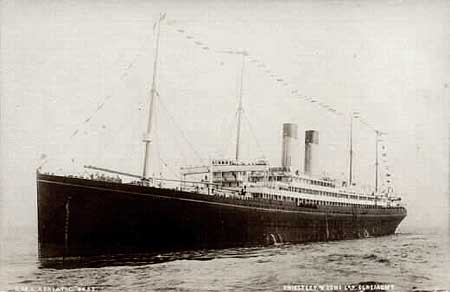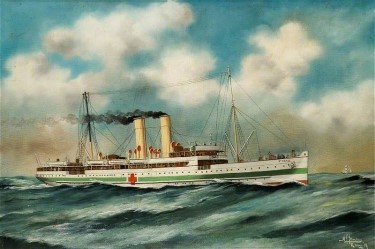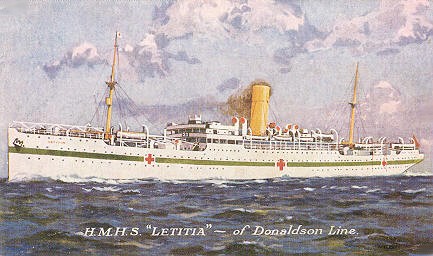|
Jun 22, 1896
|
Born in Dalhousie West, Nova
Scotia to William and Sarah (nee Ramsay) Devany
|
|
Sep 17, 1915
|
Attested into the 64th Battalion CEF
in Sussex, New Brunswick
Ø Number 470362
Ø Next of kin given as William Devany, father,
Upper Clements, Nova Scotia
Ø Previous occupation given as Fireman
Ø No previous military experience given
Ø Religion given as Roman Catholic
|
|
Jan 10, 1916
|
Appointed to the rank of Lance Corporal
|
|
Feb 15, 1916
|
Admitted to hospital with a diagnosis that reads
Rubella (Measles)
|
|
Feb 29, 1916
|
Discharged to duty from hospital
|
|
Mar 31, 1916
|
Embarked the SS Adriatic in
Halifax, Nova Scotia

|
|
Apr 9, 1916
|
Disembarked in Liverpool,
England and proceeded to the East Sandling camp where the battalion was
absorbed into the 40th Reserve Battalion
|
|
Jul 12, 1916
|
Transferred to the 21st
Battalion
|
|
Jul 14, 1916
|
Arrived at the CBD (Canadian
Base Depot) in the Rouelles Camp, Havre, France and Taken On Strength of the
21st Battalion
|
|
Aug 8, 1916
|
After leaving the base depot,
he joined the 2nd Canadian Entrenching Battalion in the Halifax
Camp, near Brandhoek, Belgium
|
|
Aug 11, 1916
|
After leaving the entrenching
battalion, Private Devany joined the 21st Battalion in the front
lines near Voormezeele, Belgium
|
|
Aug 15, 1916
|
Admitted to the No. 4 CFA
(Canadian Field Ambulance) with a diagnosis that reads PUO (Pyrexia of
Unknown Origin), a fever without a known cause. This was later changed to read Influenza
|
|
Aug 16, 1916
|
Transferred to the No. 6
Canadian Field Ambulance
|
|
Aug 18, 1916
|
Transferred to the No. 2
Division Rest Station
|
|
Aug 21, 1916
|
Discharged from the rest
station and rejoined the 21st Battalion resting in Ridgewood,
Belgium
|
|
Sep 15, 1916
|
Private Devany received a
shrapnel wound to his right shoulder and arm that fractured his humerus as he
was leaving the trench to begin the attack on the sugar factory south of
Courcelette, France. He was evacuated
to a nearby field ambulance for first aid before being transferred to a
casualty clearing station
|
|
Sep 17, 1916
|
Invalided to England aboard
the Hospital Ship St. Denis

On arrival in England, he was
admitted to the Fort Pitt Military Hospital in Chatham
Transferred to the CCAC
(Canadian Casualty Assembly Centre) for pay purposes while in hospital
|
|
Nov 28, 1916
|
Transferred to the Preston
Hall Military Hospital in Maidstone
|
|
Feb 22, 1917
|
Transferred to the Canadian
Military Hospital in Eastbourne
|
|
Mar 10, 1917
|
Transferred to the newly
formed EORD (Eastern Ontario Regimental Depot) for pay purposes while in
hospital
|
|
Mar 24, 1917
|
Granted 5 days leave
|
|
Apr 11, 1917
|
Embarked the Hospital Ship
Letitia in Liverpool

|
|
Apr 20, 1917
|
Disembarked in Halifax, Nova
Scotia
Admitted to the Convalescent
Home in Annapolis Royal, Nova Scotia
|
|
Apr 22, 1917
|
Transferred to the Pine Hill
Hospital in Halifax
|
|
Apr 27, 1917
|
X-Ray shows 2 pieces of shrapnel
in his right arm and surgery was performed to remove both pieces
|
|
Nov 10, 1917
|
To be treated as an out-patient
of the Pine Hill Hospital
|
|
Jan 6, 1918
|
To be treated as an in-patient
of the Pine Hill Hospital
|
|
Apr 6, 1918
|
Transferred to the Military
District No. 6 Casualty Company for pay purposes while in hospital
|
|
Apr 16, 1918
|
Medical exam makes note of his
shrapnel wound and shows that the strength in his right arm is reduced by 1/3
and is 1 inch shorter than his left. He
has partial loss of function of his right arm and is recommended for light
duty only
|
|
May 4, 1918
|
Discharged to duty from
hospital
|
|
May 6, 1918
|
Transferred to the Military
District No. 6 Casualty Company
|
|
May 28, 1918
|
Transferred to the No. 6
District Depot in Halifax
|
|
Jun 15, 1918
|
Promoted to the rank of
Sergeant
|
|
Oct 1, 1918
|
Appointed to the position of
Records Sergeant
|
|
Sep 25, 1919
|
Admitted to the Camp Hill
Hospital with a diagnosis that reads Osteomyelitis
|
|
Sep 30, 1919
|
Transferred to the Hospital
Section for pay purposes while in hospital
|
|
Oct 24, 1919
|
Medical exam at the Camp Hill Hospital
notes
Ø Right arm is
shorter than left
Ø Loss of function of
right arm due to adhesion to his shoulder, a result of his shrapnel wounds
Ø Complains of loss
of strength, occasional numbness and is easily tired.
Ø Board recommends
discharge from service
|
|
Oct 30, 1919
|
Discharged from hospital and transferred
to the Military District No. 6 Casualty Company
|
|
Nov 5, 1919
|
Discharged from the CEF in
Halifax, Nova Scotia
Ø Rank on discharge
Sergeant
Ø War Service Badge
Class “A” issued number 233659
Ø Proposed residence
on discharge RR #2 Royal Annapolis, Nova Scotia
Following his discharge, the
British War Medal and Victory Medals were sent to him at RR #2 Royal
Annapolis, Nova Scotia
In June, 1923, John Devany,
and his wife Edith, entered the United States and proceeded to Gary, Indiana
|
|
Apr 6, 1964
|
John Edward Devany died in
Gary, Indiana, USA and was buried in the Calumet Park Cemetery, Merrillville,
Indiana
|
|